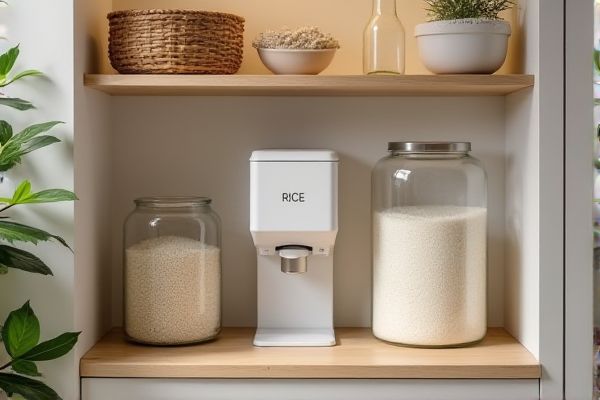
Rice dispensers offer precise measuring and easy portion control, while rice canisters provide airtight storage to maintain freshness and protect against pests. Discover which option best suits your pantry needs and enhances your kitchen efficiency by reading the rest of the article.
Table of Comparison
| Feature | Rice Dispenser | Rice Canister (Pantry) |
|---|---|---|
| Storage Capacity | Typically 5-20 lbs | Varies widely, 1-20+ lbs |
| Dispensing Method | Automatic/mechanical dispenser, measures servings | Manual scoop or pour |
| Freshness | Sealed compartments reduce exposure | Depends on lid seal quality |
| Space Efficiency | Vertical, compact design | Varies; often bulkier |
| Ease of Use | Quick, one-handed dispensing | Requires opening lid, manual scooping |
| Price Range | $20 - $60 | $10 - $50 |
| Best For | Frequent rice use, portion control | Bulk storage, variety of grains |
Introduction: Rice Dispenser vs Rice Canister
Rice dispensers offer precise portion control and airtight storage to maintain rice freshness, making them ideal for everyday convenience. Rice canisters provide larger storage capacity with simple access, often designed for bulk rice kept in pantry spaces. Choosing between a rice dispenser and a rice canister depends on usage frequency, storage needs, and kitchen organization preferences.
Space Efficiency: Maximizing Pantry Storage
Rice dispensers offer superior space efficiency by providing a compact, vertical storage solution that minimizes pantry clutter and allows for easy portion control. Rice canisters, while often larger and bulkier, can take up more horizontal space, limiting overall pantry capacity. Optimize your pantry storage by selecting a rice dispenser that fits your space constraints while ensuring freshness and accessibility.
Ease of Use and Accessibility
A rice dispenser offers quick and precise portion control, making it easier for you to access rice without lifting heavy containers or dealing with spills. Rice canisters provide straightforward storage, but require manual scooping, which can be less convenient and messier in daily use. Choosing a rice dispenser enhances accessibility with one-handed operation and clear measurement, improving kitchen efficiency.
Airtightness and Rice Freshness
Rice dispensers often feature airtight seals designed to lock out moisture and pests, helping to maintain rice freshness for longer durations compared to typical rice canisters. The airtightness of rice dispensers ensures that your rice remains dry and free from odor contamination, which is essential for preserving flavor and texture. When prioritizing rice freshness, choosing a rice dispenser with a high-quality sealing mechanism offers a better solution than most pantry rice canisters.
Capacity Comparison: How Much Rice Can You Store?
Rice dispensers typically offer storage capacities ranging from 5 to 20 kilograms, making them ideal for portion-controlled usage and quick dispensing in both home and commercial kitchens. Rice canisters, commonly made from materials like plastic, stainless steel, or ceramic, often provide larger storage volumes between 10 to 30 kilograms, suitable for bulk storage in pantry settings. The choice depends on balancing daily convenience versus long-term storage needs, with dispensers favoring measured servings and canisters accommodating higher rice quantities.
Dispensing Mechanism vs Manual Scooping
Rice dispensers feature an easy-to-use dispensing mechanism that releases a controlled portion of rice with minimal effort, ensuring convenience and reducing spillage. In contrast, rice canisters require manual scooping, which can be less precise and messier, especially when handling large amounts. Your choice depends on whether you prioritize automated portion control or traditional storage with manual access.
Cleaning and Maintenance Requirements
Rice dispensers typically require more frequent cleaning due to their mechanical parts, such as levers and spouts, which can trap dust and rice residue, making thorough maintenance essential to prevent contamination. Rice canisters offer easier maintenance with simpler designs, usually involving just a wide opening for scooping, allowing for quick cleaning and drying to keep rice fresh. Your choice should consider how much time you can dedicate to regular upkeep to ensure both options remain sanitary and functional.
Aesthetic Appeal in Modern Kitchens
A rice dispenser offers a sleek, compact design with transparent compartments that enhance the aesthetic appeal of modern kitchens by showcasing organized grains. A rice canister, often crafted from ceramic, stainless steel, or glass, provides a more traditional or minimalist look, blending seamlessly with pantry shelves and countertops. Choosing the right storage solution depends on your kitchen's style and whether you prioritize visible accessibility or a more discreet, decorative element.
Price and Value for Money
Rice dispensers typically cost more due to their convenience features like portion control and airtight seals, offering better value for busy households prioritizing freshness and ease. Rice canisters tend to be more affordable, providing basic storage without extra functionality, making them suitable for those seeking a budget-friendly pantry solution. Your choice depends on whether you prioritize cost savings or added convenience for daily rice usage.
Choosing the Right Option for Your Pantry
Selecting between a rice dispenser and a rice canister depends on storage convenience and usage frequency; rice dispensers offer controlled portioning ideal for daily use, while rice canisters provide airtight storage that preserves freshness long-term. Consider the pantry space and the quantity of rice typically stored; dispensers are space-efficient with easy access mechanisms, whereas canisters vary in size and enhance freshness by preventing moisture and pests. Prioritize your kitchen routine and storage environment when choosing to maintain rice quality and streamline meal preparation.
 homyna.com
homyna.com